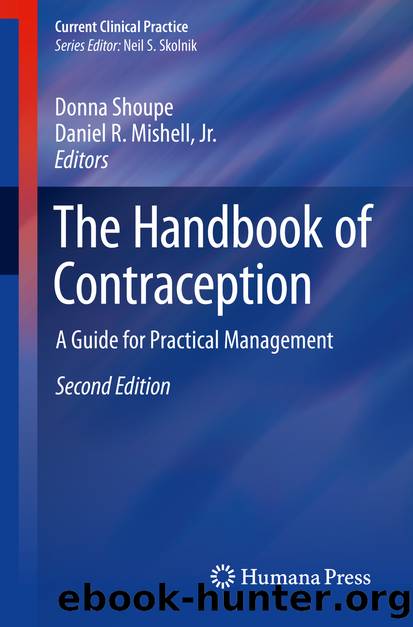The Handbook of Contraception by Donna Shoupe & Daniel R. Mishell Jr

Author:Donna Shoupe & Daniel R. Mishell, Jr.
Language: eng
Format: epub
Publisher: Springer International Publishing, Cham
Counseling
Irregular Bleeding
Unscheduled bleeding is a common side effect, which may or may not decrease with continued use. Because implants allow for follicular development but not ovulation, endogenous estrogen production is nearly normal, and unlike the combined estrogen-progestin contraceptives, progestin is not regularly withdrawn to allow endometrial sloughing. Consequently, the endometrium sheds at unpredictable intervals and menstrual bleeding patterns can be highly variable among users of implant contraception. Changes include alterations in the interval between bleeding, the duration and volume of menstrual flow, and spotting.
In the analysis of 11 clinical trials, unscheduled bleeding was the primary reason for discontinuation, with a rate of 14.8 % in the United States and Europe, but only 3.7 % in Southeast Asia, Chile, and Russia [12]. United States users were more likely to discontinue because of prolonged or heavy bleeding than women from other countries (7.0 vs. 4.3 %). The mean number of bleeding and spotting days per 90-day reference period was 7.3 and 10.4 days, respectively. One third of 90-day reference periods had fewer than three bleeding/spotting episodes; one fifth had no bleeding/spotting (amenorrhea); 17 % had a bleeding episode that lasted more than 14 days; and 6 % had more than five bleeding/spotting episodes. The number of unscheduled bleeding days was highest in the first 3 months of use, decreased during the first year of use, and then plateaued for the second and third years of use. However, this decrease may have resulted from patients discontinuing as a result of a bleeding irregularity, leaving for analysis those less likely to experience bleeding. Although amenorrhea occurs in approximately 20 % of women in the first year of use, the rates of amenorrhea actually decline with duration of use to 13 % by year 3 [42].
Women who experienced more days of bleeding were more likely to discontinue, especially if the bleeding was prolonged. For example, the mean number of bleeding/spotting days in women who discontinued and who continued implant use during a 90-day reference period was 45.2 and 16.5 days, respectively. Frequent or prolonged bleeding/spotting was reported in about 90 % of women who discontinued the implant but in only 22 % of those who continued its use [43].
Download
This site does not store any files on its server. We only index and link to content provided by other sites. Please contact the content providers to delete copyright contents if any and email us, we'll remove relevant links or contents immediately.
Periodization Training for Sports by Tudor Bompa(7891)
Why We Sleep: Unlocking the Power of Sleep and Dreams by Matthew Walker(6307)
Paper Towns by Green John(4757)
The Immortal Life of Henrietta Lacks by Rebecca Skloot(4226)
The Sports Rules Book by Human Kinetics(4048)
Dynamic Alignment Through Imagery by Eric Franklin(3891)
ACSM's Complete Guide to Fitness & Health by ACSM(3792)
Kaplan MCAT Organic Chemistry Review: Created for MCAT 2015 (Kaplan Test Prep) by Kaplan(3776)
Introduction to Kinesiology by Shirl J. Hoffman(3605)
Livewired by David Eagleman(3515)
The River of Consciousness by Oliver Sacks(3385)
The Death of the Heart by Elizabeth Bowen(3314)
Alchemy and Alchemists by C. J. S. Thompson(3270)
Descartes' Error by Antonio Damasio(3141)
Bad Pharma by Ben Goldacre(3068)
The Gene: An Intimate History by Siddhartha Mukherjee(2898)
The Emperor of All Maladies: A Biography of Cancer by Siddhartha Mukherjee(2883)
The Fate of Rome: Climate, Disease, and the End of an Empire (The Princeton History of the Ancient World) by Kyle Harper(2841)
Kaplan MCAT Behavioral Sciences Review: Created for MCAT 2015 (Kaplan Test Prep) by Kaplan(2783)
